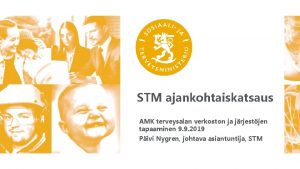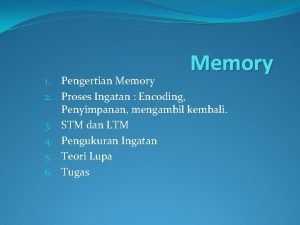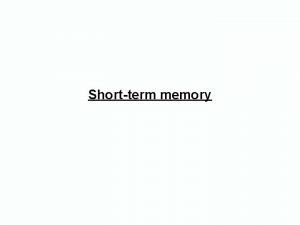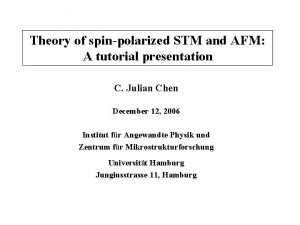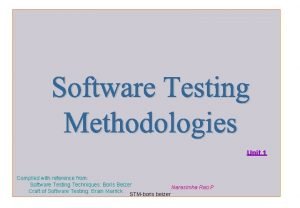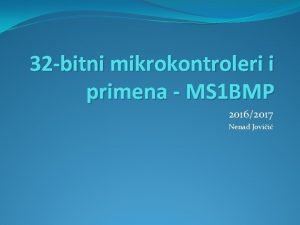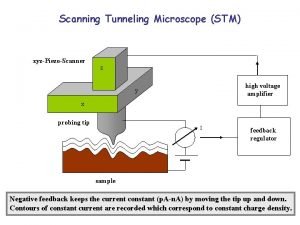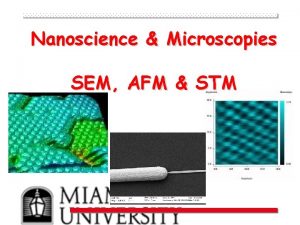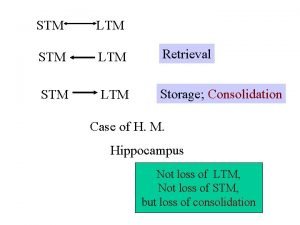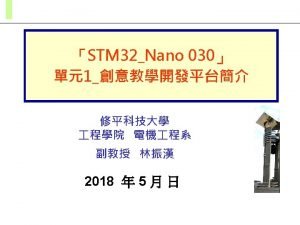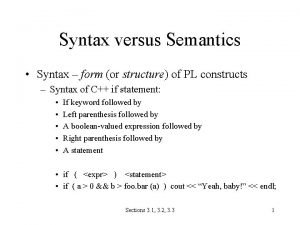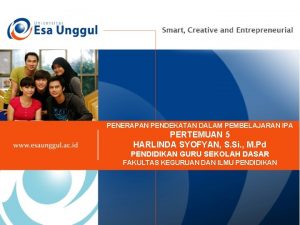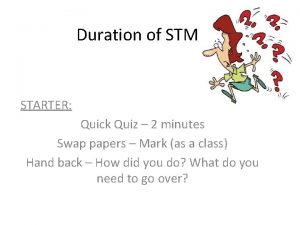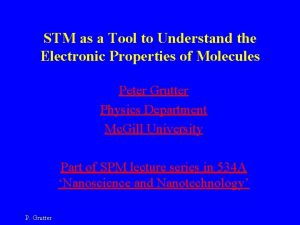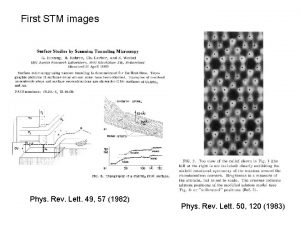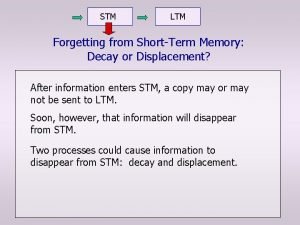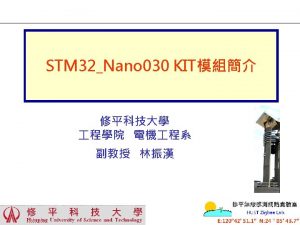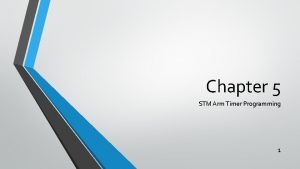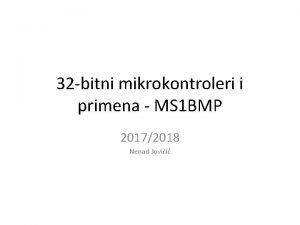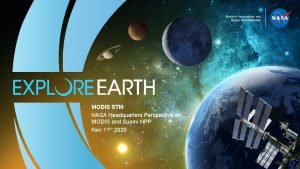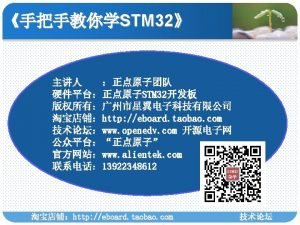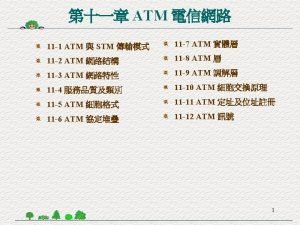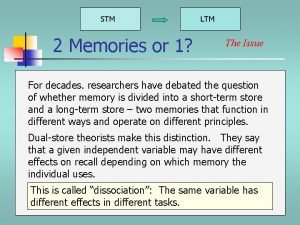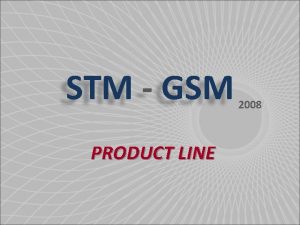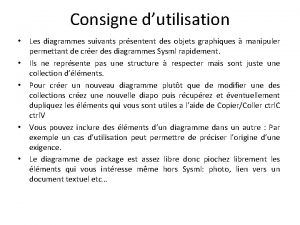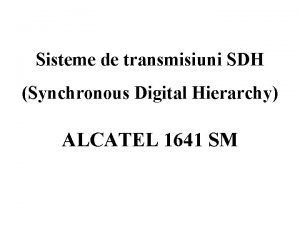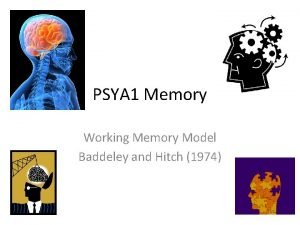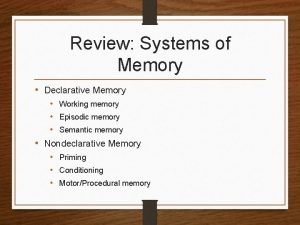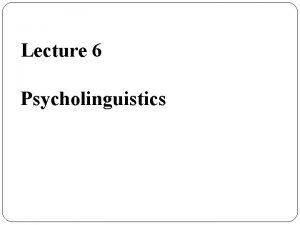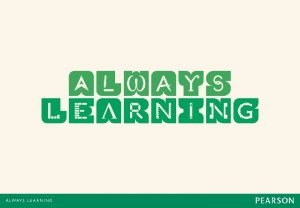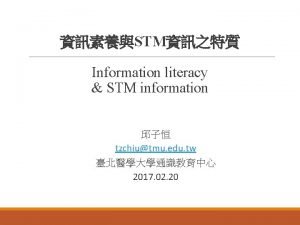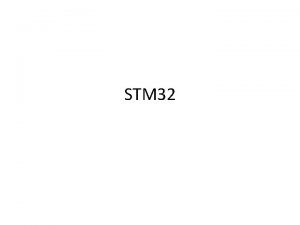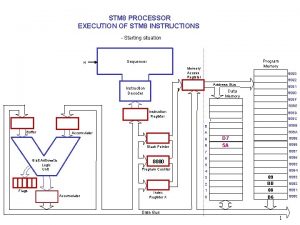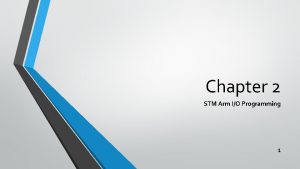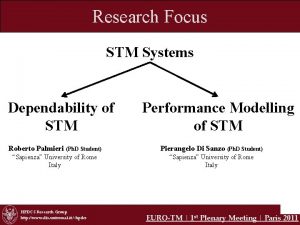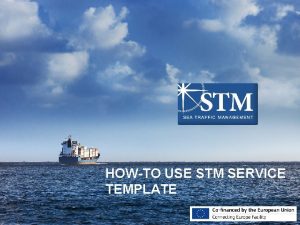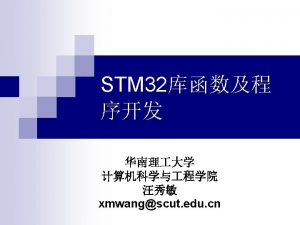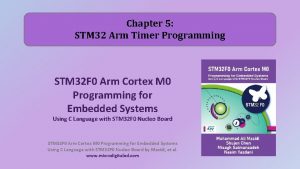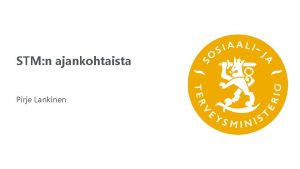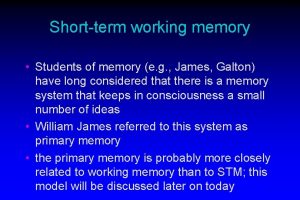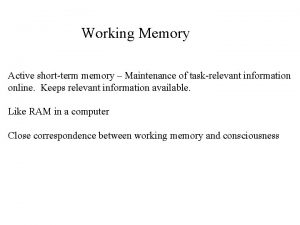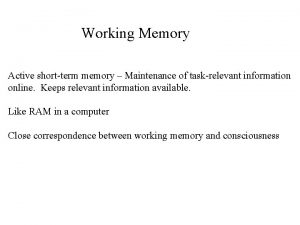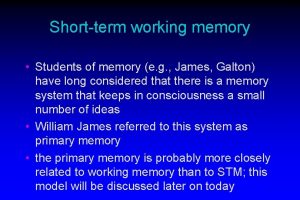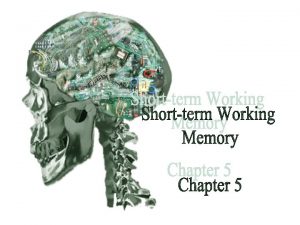SHORTTERM MEMORY WORKING MEMORY OUTLINE STM WM 1









































- Slides: 41

SHORT-TERM MEMORY / WORKING MEMORY

OUTLINE: STM / WM 1. Describe various forms of memory and the different types of tests used to assess them. 2. Summarize the Atkinson & Shiffrin / Multi-Modal Model of memory. 3. Outline the key features of the sensory registers and Short-term Memory including: • Capacity • Duration • Search (serial vs. parallel) • Forgetting (interference vs. decay) • Coding (perceptual vs. conceptual) 4. Contrast STM and Working Memory (Baddeley).

VARIETIES OF MEMORY 1. Who wrote ‘A Prayer for Owen Meany’? 2. What shoes did I wear last week? 3. You are at Vals and are in a good mood because it’s Eggs Mc. Chucks Day. But, your friend gets a little too excited bites off more than s/he can chew and starts to choke. What do you do? 4. Whom did you take to the senior prom? 5. What would you do if the Paris Metro went on strike? 6. All Champagne is produced in a small region of: a) France b) Germany c) Italy d) Camden, NJ 7. Who played Legolas? (Important Legolas video)

POTENTIAL CAUSES FOR MEMORY FAILURES Can you recall a recent time you forgot something? Why did you forget whatever it was that you forgot? There are 3 possibilities: • Encoding failure • Storage failure • Retrieval failure

COMMON EXPLICIT MEMORY TESTS: RECALL EXPLICIT MEMORY - conscious access of target information DECLARATIVE MEMORY - conscious access of facts Type of Test Learning Test Free / Serial Recall 8 -6 -7 -5 -3 -0 -9 Cued Recall Foot-watch Cereal-bowl Foot_______ Cereal______ Comphensio n Read story about Statue of Liberty? How long is her extended arm? Public Knowledge Which Spice Girl was the 1 st to leave? Response

COMMON EXPLICIT MEMORY TESTS: RECALL EXPLICIT MEMORY - conscious access of target information DECLARATIVE MEMORY - conscious access of facts Type of Test Learning Test Free / Serial Recall 8 -6 -7 -5 -3 -0 -9 Cued Recall Foot-watch Cereal-bowl Foot_______ Cereal______ Comphensio n Read story about Statue of Liberty? How long is her extended arm? Public Knowledge Response 8 -6 -7 -5 -3 -0 -9 Which Spice Girl was the 1 st to leave? Watch Bowl

COMMON EXPLICIT MEMORY TESTS: RECOGNITION Type of Test Learning True/ False Multiple Choice Old / New Recognition Passage (or not) Test Posh Spice is married to Michael Beckham Passage (or not) My favorite spice girl is: Posh Ginger Baby Scary Sporty Foot Watch Cereal Bowl Foot Stereo Cheese Bowl Response

COMMON IMPLICIT MEMORY TESTS Implicit Memory – is observed when a person demonstrates knowledge of or prior exposure to information without directly being asked about prior experience. Both ‘accuracy’ and RT are measured and compared across a control group and an experimental group. Type of Test Learning Test Naming E: turkey C: computer Lexical Decision E: turkey C: computer Turkey Greeble Foot Watch Cereal Bowl Tur___ Stem Completion Turkey Response

COMMON PROCEDURAL MEMORY TESTS Procedural memory – memory for skills and other nonverbal information. You demonstrate memory by doing rather than saying. • Mirror Writing • Tower of Hanoi puzzle Can you think of any ways that you demonstrate procedural memory on a regular / everyday basis? Why is this interesting? • Amnesic patients • So what?

FOUR TYPES OF MEMORY TESTS Declarative Procedural Explicit Implicit

MEMORY TEST INSTRUCTIONS Intentional – I’m going to test you later • SAT and academic work • Majority of memory research Incidental – Let’s just do this for fun (sinister laugh…but I’m going to test you later) • Rate these words • Remember content, but test on source • Time estimation tasks

MULTI-MODAL MODEL OF MEMORY – ATKINSON AND SHIFFRIN (1968) Stimuli in the world Sensory Register s STM Response Output LTM

IMPORTANT QUESTIONS: SENSORY MEMORY 1. Capacity 2. Duration 3. Coding 4. Search 5. Forgetting

IMPORTANT QUESTIONS: SENSORY MEMORY 1. Capacity • Full v Partial Report • Size of Display • Manipulation of ISI 2. Duration • ISI 3. Coding • Pattern Masking • Report all letters that rhyme with ‘B’ 4. Search. <Pass> 5. Forgetting • Decay v Interference

ANSWERS TO KEY QUESTIONS Capacity Duration Sensory Memory VERY large Very short Coding Physical (analog) Search Forgetting cough Decay / Interference STM

STM: CAPACITY The ‘Magic’ Number: 7± 2 items of information • Memory span studies • Chunking (recoding) • Serial position effects Primacy Recency

STM: DURATION With Rehearsal • Maintenance Rehearsal • Elaborative Rehearsal (recoding / imagery) • Serial position effects Without Rehearsal

BROWN PETERSON: BLOCKED V MIXED PRESENTATION

BROWN PETERSON: BLOCKED V MIXED PRESENTATION

STM: SEARCH – STERNBERG TASK Logic of Subtraction How long does process C take? 1. Have people do A+B+C 2. Then, have people do A+B RT(C) = RT 1 – RT 2 Assumptions: • Discrete stages • Pure insertion

STM: SEARCH – STERNBERG TASK Sternberg Task • Give people a list of digits • Ask them if target was on that list • Vary the number of digits in the list • Use slope of the regression line to determine search time per item. Stage Encode Target Scan Items in Memory Make Decision Make Response N Letters N+1 Letters

STM: SEARCH – STERNBERG TASK Sternberg Task • Give people a list of digits • Ask them if target was on that list • Vary the number of digits in the list • Use slope of the regression line to determine search time per item. Stage Encode Target N Letters N+1 Letters Same Scan Items in Memory Make Decision Make Response

STM: SEARCH – STERNBERG TASK RESULTS Key Results: 1. Linear increase with a slope of 40 ms 2. No difference between ‘Present’ and ‘Absent’ Trials Q: How do these results compare to Visual Search

STM: SEARCH – STERNBERG COGLAB RT not significantly different across Present v Absent Present: m = 61 ms Absent: m = 44 ms

STM: SEARCH – WHY HAVE AN EXHAUSTIVE SEARCH? To avoid switching costs. Sternberg’s idea was that a homonculus does all the comparisons then looks at the readout to assess presence or absence • Going to dinner with a group of people (pre-group text era)

STM: FORGETTING – DECAY V INTERFERENCE (THIS IS WHEN IT STARTS GETTING NASTY) Decay – As time passes, information begins to crumble, fade, break apart, recede into oblivion, pass through the veil. Interference – can happen two ways. 1. NEW information pushes old information OUT. 2. OLD information doesn’t let new information IN.

STM: FORGETTING – EVIDENCE Supports Decay Supports Interference Brown. Peterson Longer RI = Intrusions Mixed Bloc Serial Position Effects Longer RI = Surrounding Items Can we eliminate interference? • Cockroach studies • Sleep Studies • Anesthesia Studies

STM: FORGETTING – MORE EVIDENCE Waugh & Norman (1965) Manipulated Presentation rate. Interference Predicts: No effect Decay Predicts: Reduced Primacy Crowder & Morton (1969) Suffix Effect Interference Predicts: Reduced recency Decay Predicts: No effect

STM: FORGETTING – MORE EVIDENCE Interference is a two-way street 1. Retroactive Interference – NEW items interfere with OLD • Common room noise 2. Proactive Interference – OLD items interfere with NEW • Phone numbers • Parking Spaces • Release from PI

ANSWERS TO KEY QUESTIONS Capacity Duration Sensory Memory VERY large Very short Coding Physical (analog) Search cough Forgetting Decay / Interference STM 7± 2 Don’t get me started Largely Physical Serial and Exhaustive Decay, RI, and PI

BADDELEY’S WORKING MEMORY MODEL Why revamp the modal model? 1. Difficult to empirically dissociate STM from LTM a) Sensitive to many of the same manipulations EX: Name the US Presidents 2. Population Evidence a) Some populations show poor performance on some STM tasks, but not others. 3. STM is dynamic a) Not a passive storehouse of information; STM manipulates information, as well. EX: Release from PI Memory span tasks

ARCHITECTURE OF THE WORKING MEMORY MODEL Central Executive Retrieves information from LTM Transfers information into LTM Reasoning, Decision Making Language Comprehension Response Initiation Phonological Loop Visual. Spatial Sketch Pad

COMPARING STM AND WM Phenomenologically Similar Both refer to the conscious part of memory Structurally Distinct STM – Unitary; a lone box fighting for cognitive justice in an unjust world WM – Tertiary; three components working together Conceptually Distinct STM – Contents oriented How much can we hold? How is information lost? WM – Process oriented How do we represent / manipulate information?

WM: CODING INFORMATION Phonological codes (Phonological Loop) • Phonological Similarity Effect Visual Codes (VSSP) • Rotation Studies • Other Imagery Tasks Semantic codes (Central Executive) • Release from PI

COMPARING STM AND WM: PARSIMONY QUESTION Q: Didn’t we say simpler theories were better? Isn’t STM (one box) simpler than WM (three distinct parts)? A: Yes. WM is less parsimonious, but parsimony must be weighed against the ability to: • Explain existing data • Make new predictions

WM – UNIQUE PREDICTION #1: ARTICULATORY SUPPRESSION Prediction #1 If: CE uses a semantic code and PL uses a phonological code Then: articulatory suppression should affect phonological processing but not comprehension. Evidence: • AS abolishes the phonological similarity effect • AS does not affect comprehension

WM – UNIQUE PREDICTION #2: WORD LENGTH EFFECT Prediction #1 If: PL is like a continuously recycling piece of audio tape Then: STM capacity should be affected by both the length and the number of the to-be-remembered items. Evidence: • Cross-cultural differences in IQ (digit span) • Word length effect

BADDELEY, THOMSON, & BUCHANAN (1975) Intro 1. Why is 7 ± 2 a problematic characterization of capacity? 2. What are primary memory and secondary memory? 3. Reading rate predicts memory: why is that not sufficient proof that ‘chunks’ are not a good measure of capacity? Methods & Results Experiment Control Var Exper Var Results I Frequency # of syllables Short > Long II Category # of syllables Short > Long III # of syllables Artic Time Short > Long IV Phonemes Artic Time Short > Long

BADDELEY, THOMSON, & BUCHANAN (1975) Methods & Results (continued) Experiment Control Var Exper Var Results V Same Visual Presentation Short > Long AR Mem VI Category Familiarity # of syllables Order Short > Long Linear slope VII # of syllables Artic Sup VIII # of syllables Artic Sup Modality Short > Long AS absolished WLE Short > Long AS absolished

BADDELEY, THOMSON, & BUCHANAN (1975) Discussion: 1. Why do the modality data matter? • Visual info transferred to a phonological code for rehearsal 2. How is information represented/coded in STM? • Phonological / physical code 3. How best to describe STM capacity? • Time: 1. 3 to 1. 6 seconds 4. Why doesn’t recency show an effect of word length? • Nothing replaces last items in the PL

PROBLEMS WITH THE WORKING MEMORY MODEL 1) Not much known about VSSP 2) Central Executive "Area of Residual Ignorance" • Why is that a problem?
 Memory ki paribhasha
Memory ki paribhasha Shortterm housing
Shortterm housing Which memory is the actual working memory?
Which memory is the actual working memory? Advantage of hot working
Advantage of hot working Hot working and cold working difference
Hot working and cold working difference Differentiate between hot working and cold working
Differentiate between hot working and cold working Smart work vs hard work
Smart work vs hard work Proses pengerjaan panas
Proses pengerjaan panas Päivi nygren stm
Päivi nygren stm Perbedaan stm dan ltm
Perbedaan stm dan ltm Stm capacity
Stm capacity Stm tutorial
Stm tutorial Stm 32f7
Stm 32f7 Taxonomy of bugs in stm
Taxonomy of bugs in stm Stm mikrokontroler
Stm mikrokontroler Stm
Stm Stm diagram
Stm diagram Stm ltm
Stm ltm Stm-030
Stm-030 Syntax vs semantics
Syntax vs semantics Kelemahan pendekatan faktual
Kelemahan pendekatan faktual Duration of stm
Duration of stm S9086-kc-stm-010/300, rev 10
S9086-kc-stm-010/300, rev 10 Stm as
Stm as Stm erp
Stm erp 49 stm
49 stm Stm ltm
Stm ltm Stm
Stm Stm arm
Stm arm Gpiox_moder
Gpiox_moder Stm nasa
Stm nasa Stm 32f4
Stm 32f4 Synchronous transfer mode
Synchronous transfer mode Stm and ltm
Stm and ltm Gsm gearbox
Gsm gearbox Diagramme stm
Diagramme stm Synchronous digital hierarchy
Synchronous digital hierarchy Sandwich quotation
Sandwich quotation Baddeley's theory of working memory
Baddeley's theory of working memory Working memory
Working memory Difference between phonetics and phonology
Difference between phonetics and phonology Automated working memory assessment
Automated working memory assessment








